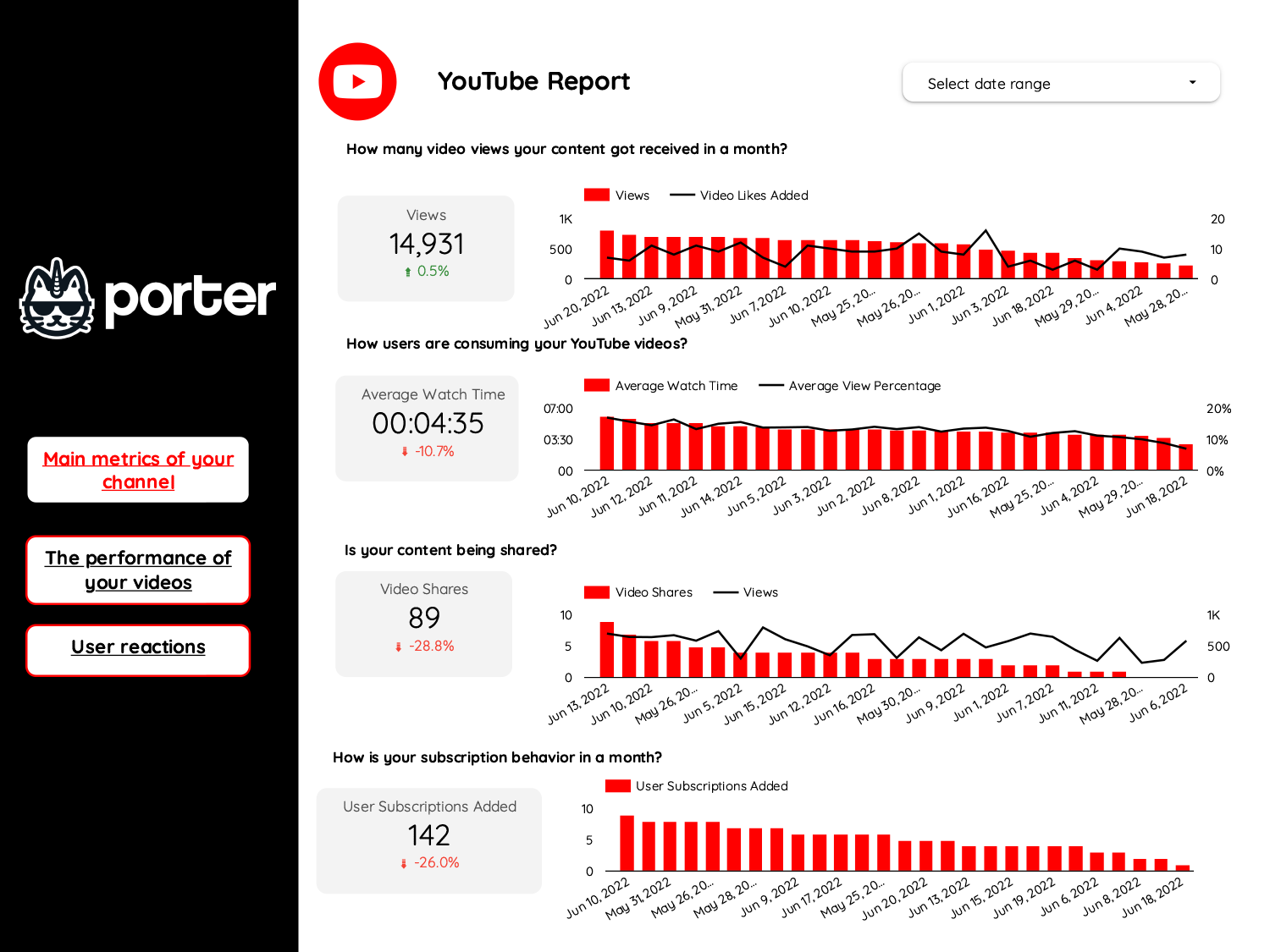
Youtube Dashboard template
Introducing the YouTube Dashboard Template—a powerful tool designed for social media managers and SEO specialists. This template provides a structured approach to managing and analyzing your YouTube channel’s performance.
With this dashboard, you can:
- Track subscriber growth and engagement metrics.
- Analyze video performance with detailed analytics.
- Monitor SEO metrics to optimize video visibility.
- Organize content strategy with a content calendar.
Designed for seamless integration with your existing workflow, this template is an essential tool for maximizing your YouTube channel’s potential.
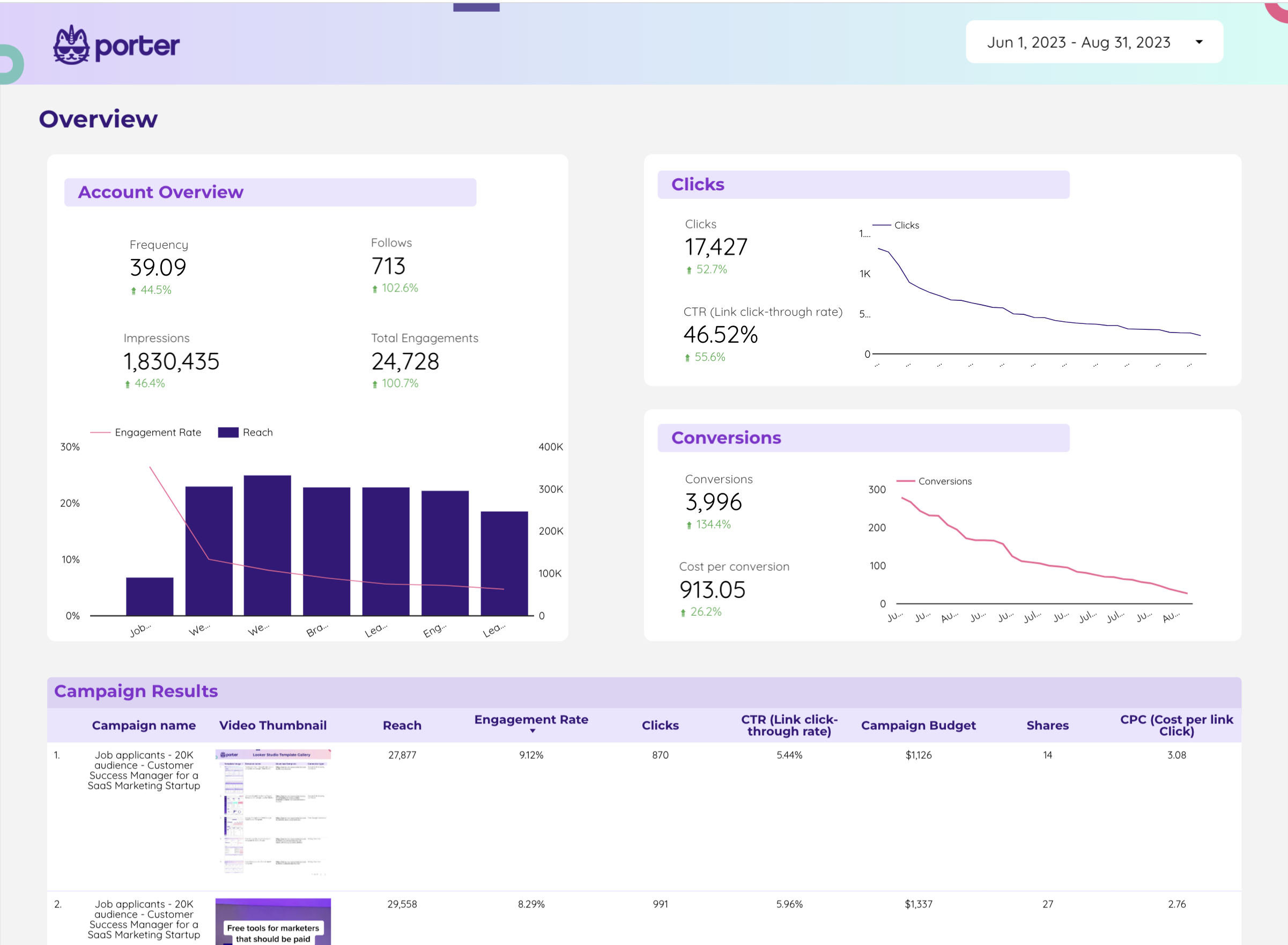
Twitter Ads Dashboard template
The Twitter Ads Dashboard Template is designed for PPC professionals seeking to streamline their advertising efforts on X Ads. This template provides a structured approach to managing and analyzing Twitter Ads campaigns.
With this dashboard, you can:
- Track campaign performance with real-time data updates.
- Monitor ad spend and compare it against budget allocations.
- Analyze audience engagement metrics to optimize targeting strategies.
- Visualize conversion rates and assess the effectiveness of ad creatives.
Utilize this template to maintain a clear overview of your Twitter Ads campaigns, ensuring data-driven decisions and maximizing ROI.
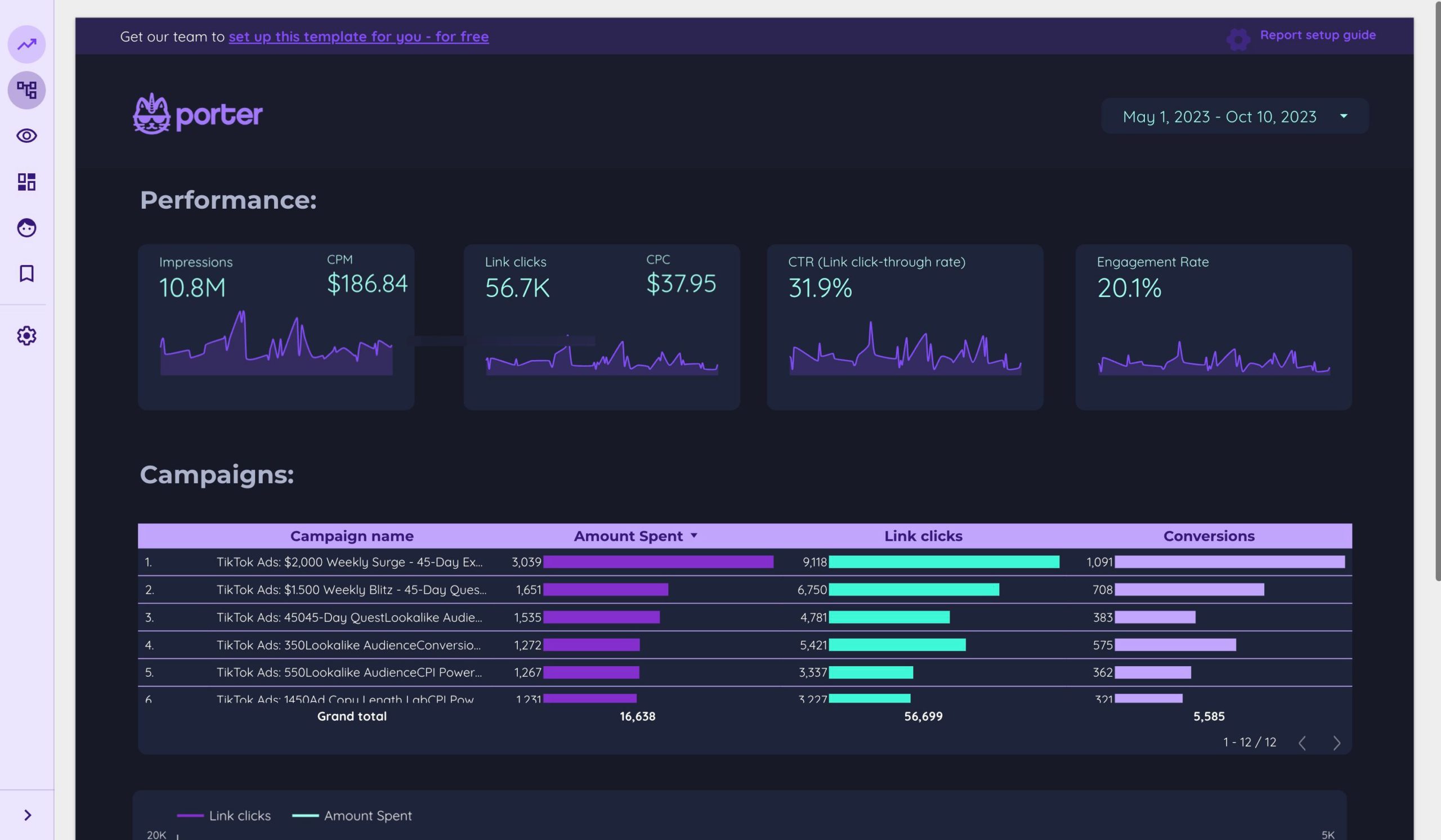
TikTok Ads Dashboard template
The TikTok Ads Dashboard Template is designed for PPC professionals managing TikTok advertising campaigns. This template provides a structured approach to monitor and analyze your ad performance effectively.
With this dashboard, you can:
- Track Ad Spend: Monitor your daily, weekly, and monthly ad expenditures to ensure budget adherence.
- Analyze Performance Metrics: Evaluate crucial metrics such as impressions, clicks, and conversions to assess campaign success.
- Visualize Data Trends: Utilize charts and graphs to identify patterns and make informed decisions.
- Optimize Campaigns: Use data insights to adjust targeting, creatives, and bidding strategies for improved results.
This template is an essential tool for PPC managers aiming to maximize their TikTok advertising efforts.
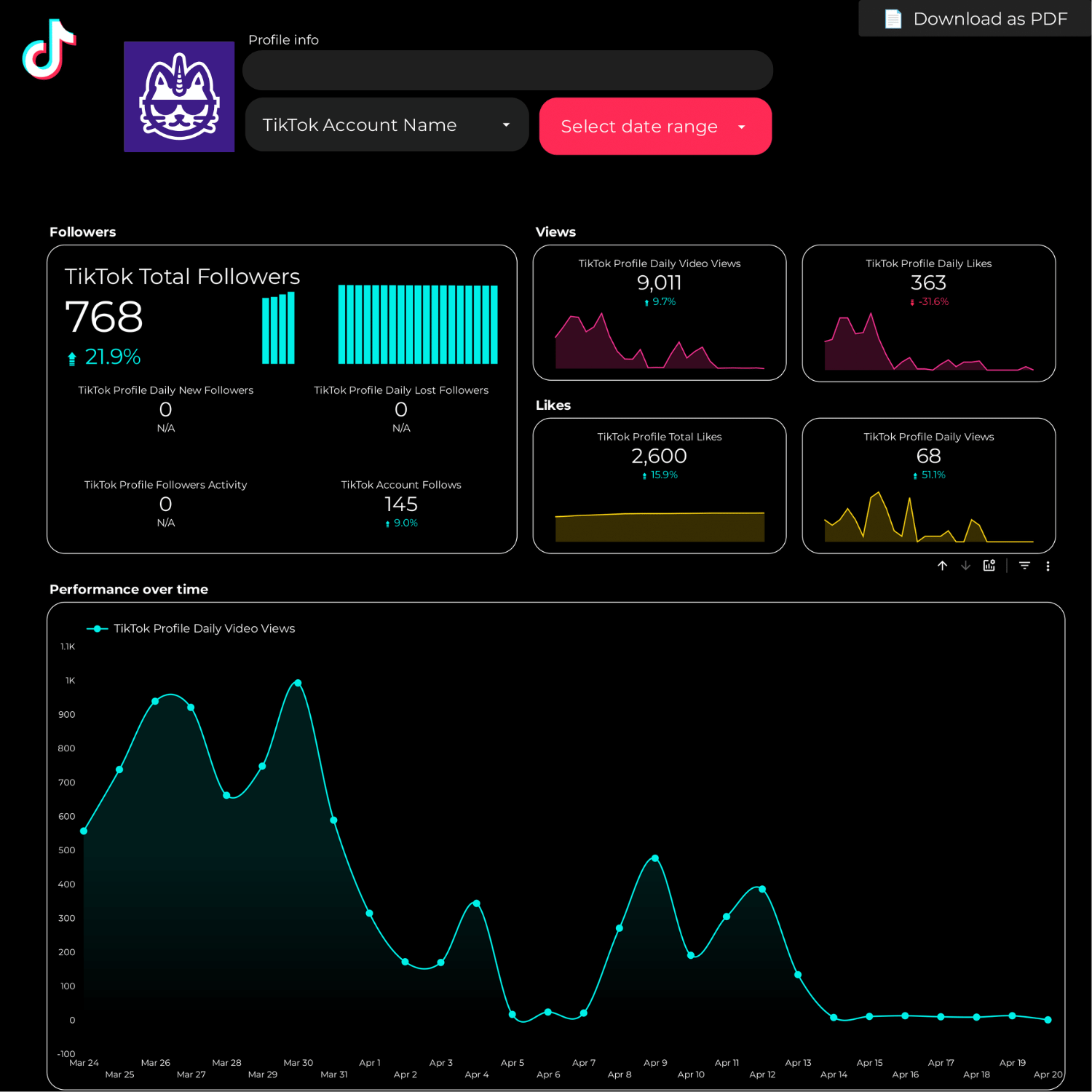
TikTok Dashboard template
Introducing the TikTok Dashboard Template, a powerful tool designed for social media managers and content creators. This template provides a structured approach to monitor and analyze your TikTok performance.
With this dashboard, you can:
- Track Follower Growth: Monitor changes in your follower count over time.
- Analyze Engagement Rates: Evaluate likes, comments, and shares to understand audience interaction.
- Content Performance: Identify top-performing videos and trends.
- Audience Insights: Gain insights into your audience demographics and preferences.
Utilize this template to streamline your TikTok strategy and make informed decisions based on data-driven insights.
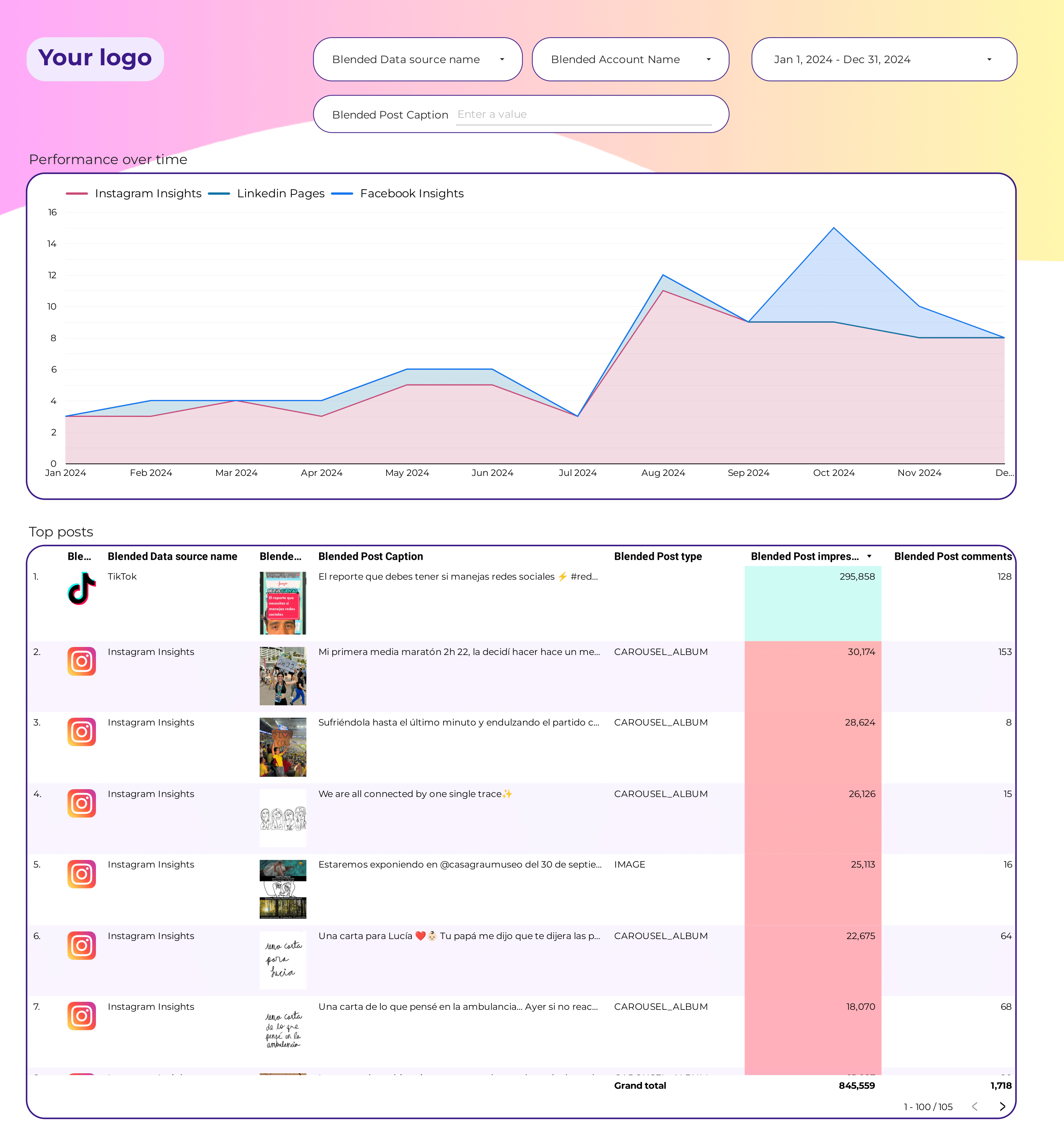
Social Media Post performance Dashboard template
Introducing the Social Media Post Performance Dashboard template, designed for seamless integration with platforms like Instagram Insights, Facebook Insights, LinkedIn Pages, TikTok, Google Business Profile, and Pinterest.
This dashboard provides a centralized view of your social media metrics, allowing you to track and analyze performance across multiple channels.
- Instagram Insights: Monitor engagement rates, follower growth, and content reach.
- Facebook Insights: Analyze post interactions, audience demographics, and page views.
- LinkedIn Pages: Evaluate post impressions, click-through rates, and follower analytics.
- TikTok: Track video views, likes, shares, and audience engagement.
- Google Business Profile: Review customer interactions, search visibility, and profile visits.
- Pinterest: Assess pin performance, audience insights, and traffic sources.
Utilize this dashboard to streamline your social media strategy and make informed decisions based on real-time data.
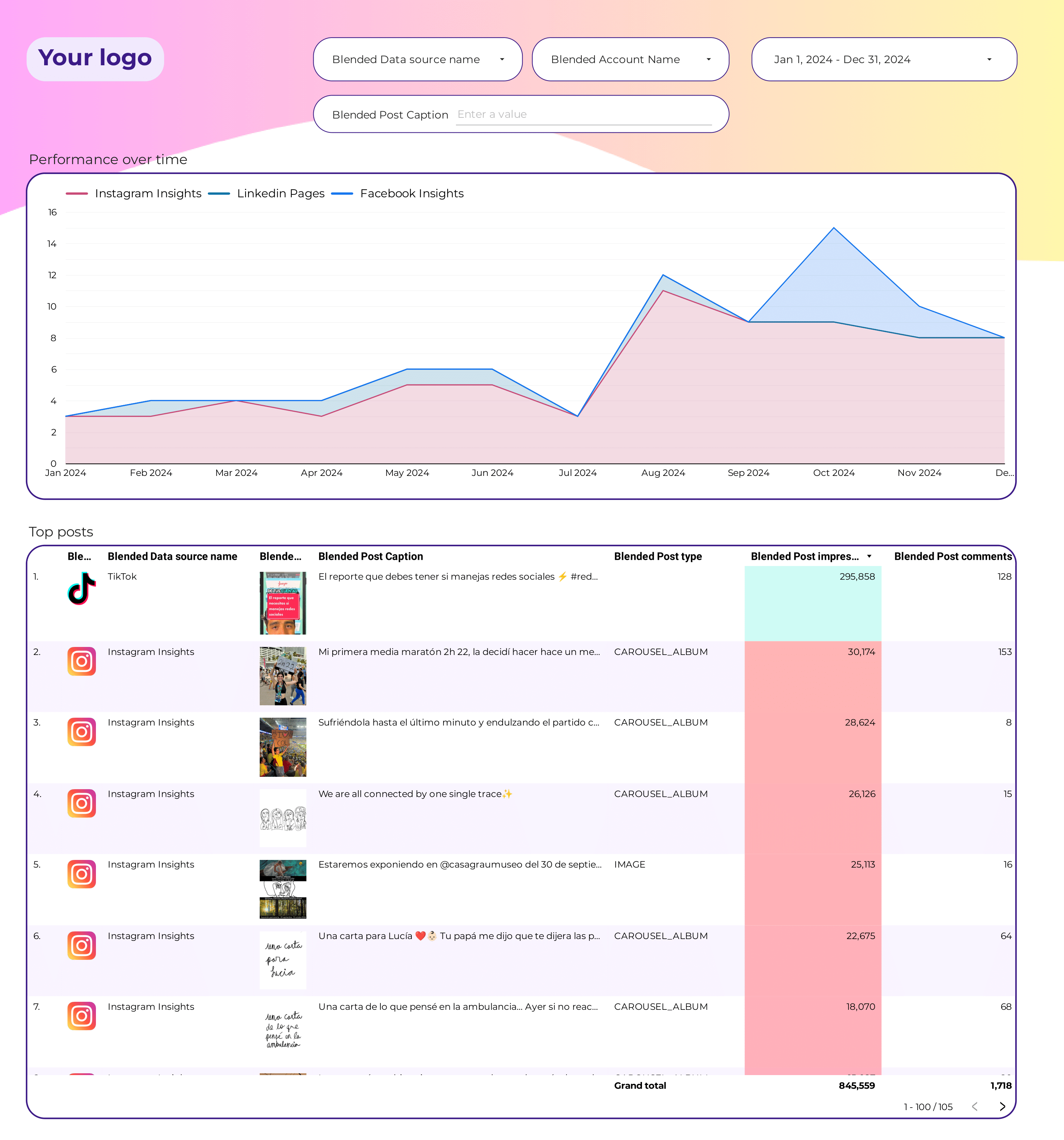
Social Media Engagement Dashboard template
The Social Media Engagement Dashboard template provides a centralized platform for tracking and analyzing performance across multiple social media channels. This tool is designed for marketers and social media managers who need to monitor and report on engagement metrics.
With this dashboard, users can access insights from:
- Instagram Insights – Analyze follower growth, post engagement, and story interactions.
- Facebook Insights – Track page likes, post reach, and audience demographics.
- LinkedIn Pages – Monitor visitor analytics, post performance, and follower trends.
- TikTok – Evaluate video views, follower activity, and engagement rates.
- Google Business Profile – Review customer interactions, search visibility, and review metrics.
- Pinterest – Assess pin performance, audience insights, and traffic sources.
This dashboard aggregates data to provide a holistic view of social media performance, allowing for data-driven decision-making and strategic planning.
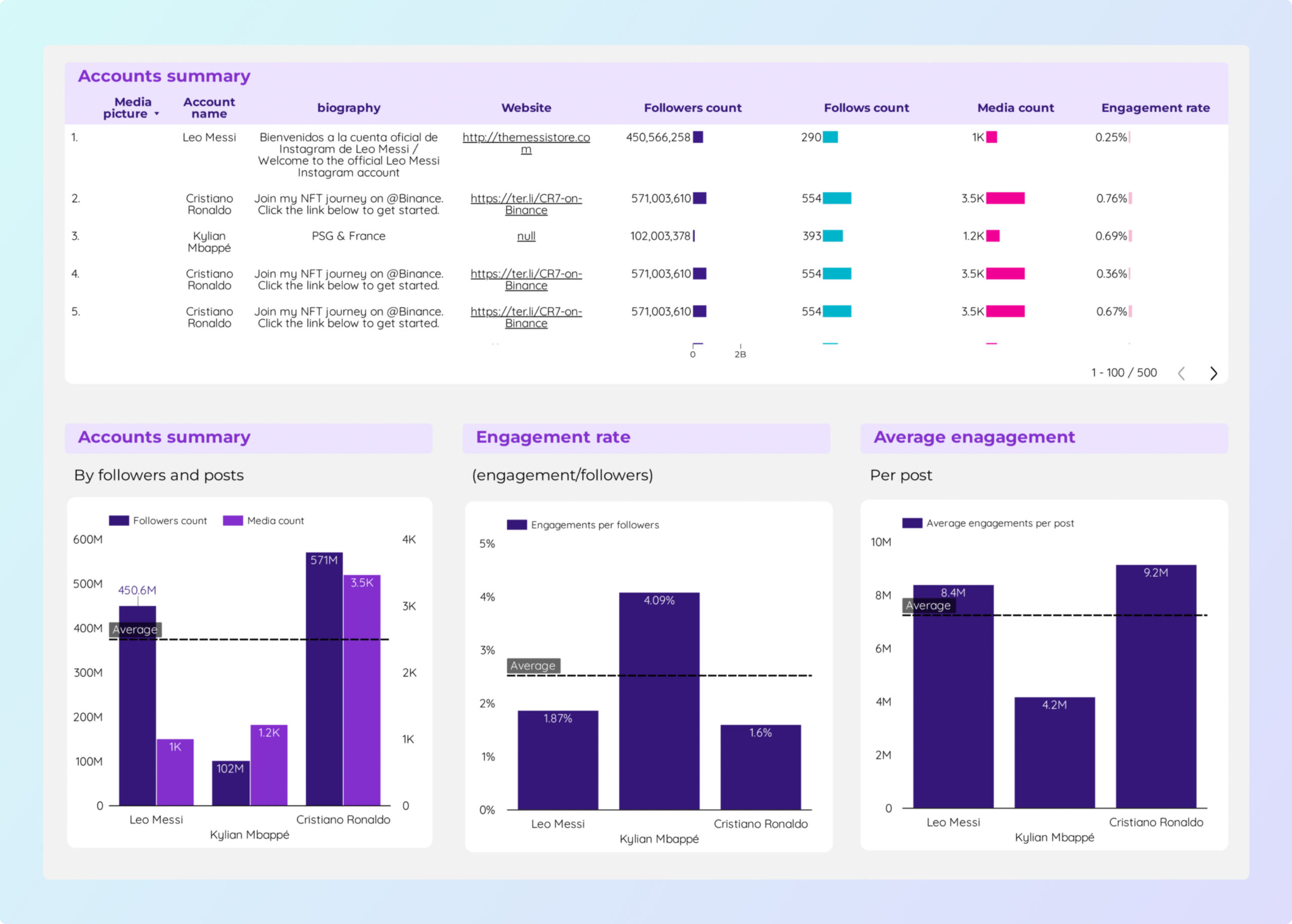
Social Media competitors Dashboard template
Introducing the Social Media Competitors Dashboard Template, a powerful tool designed for analyzing and comparing public data across multiple social media platforms. This template provides insights into your competitors’ performance on platforms such as Instagram, Facebook, LinkedIn, Google Business Profile, Pinterest, and TikTok.
Utilize this dashboard to access:
- Instagram Public Data: Track follower growth, engagement rates, and content performance.
- Facebook Insights: Analyze page likes, post reach, and audience demographics.
- LinkedIn Pages: Monitor company page followers, post interactions, and industry benchmarks.
- Google Business Profile: Evaluate customer reviews, search visibility, and local engagement.
- Pinterest: Assess pin performance, audience interests, and traffic sources.
- TikTok: Examine video views, follower trends, and engagement metrics.
This template is designed to provide a structured overview of your competitors’ social media strategies, allowing you to make informed decisions based on real-time data.
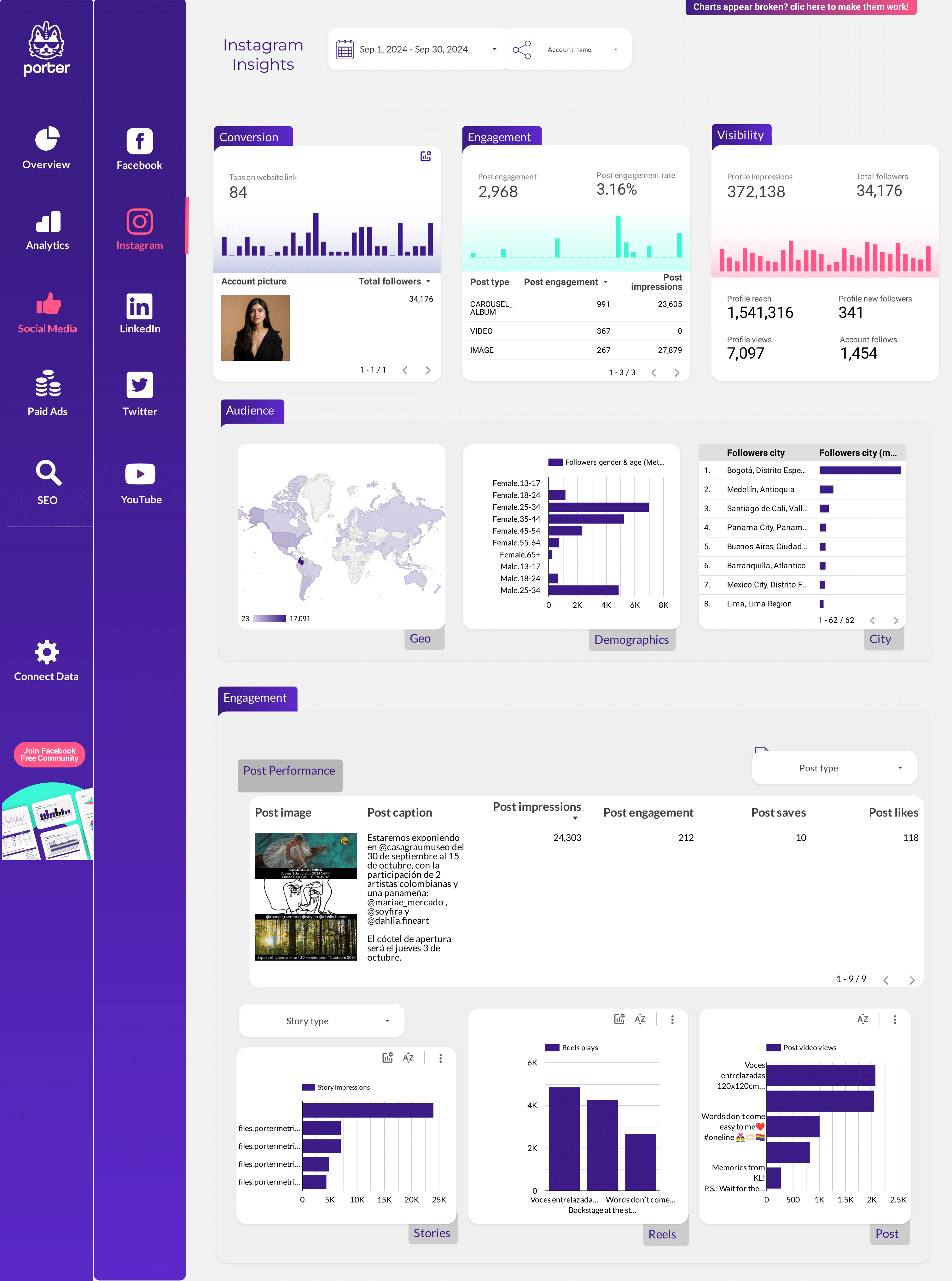
Social Media Client presentation Dashboard template
The Social Media Client Presentation Dashboard template is designed for agencies managing multiple social media platforms. It provides a structured overview of public data and insights from various social media channels.
Instagram Public Data and Instagram Insights offer detailed analytics on audience engagement and content performance. This includes metrics such as likes, comments, and follower growth.
Facebook Insights deliver data on page interactions, post reach, and demographic information, allowing for a thorough analysis of audience behavior.
For LinkedIn Pages, the dashboard presents data on post engagement, follower demographics, and page views, facilitating a deeper understanding of professional audience interactions.
Google Business Profile metrics include search visibility, customer actions, and review analytics, providing a comprehensive view of business presence on Google.
The dashboard also integrates data from Pinterest and TikTok, offering insights into pin performance, video views, and audience engagement trends.
- Track and compare performance across multiple platforms.
- Access detailed insights for strategic decision-making.
- Utilize data-driven reports for client presentations.
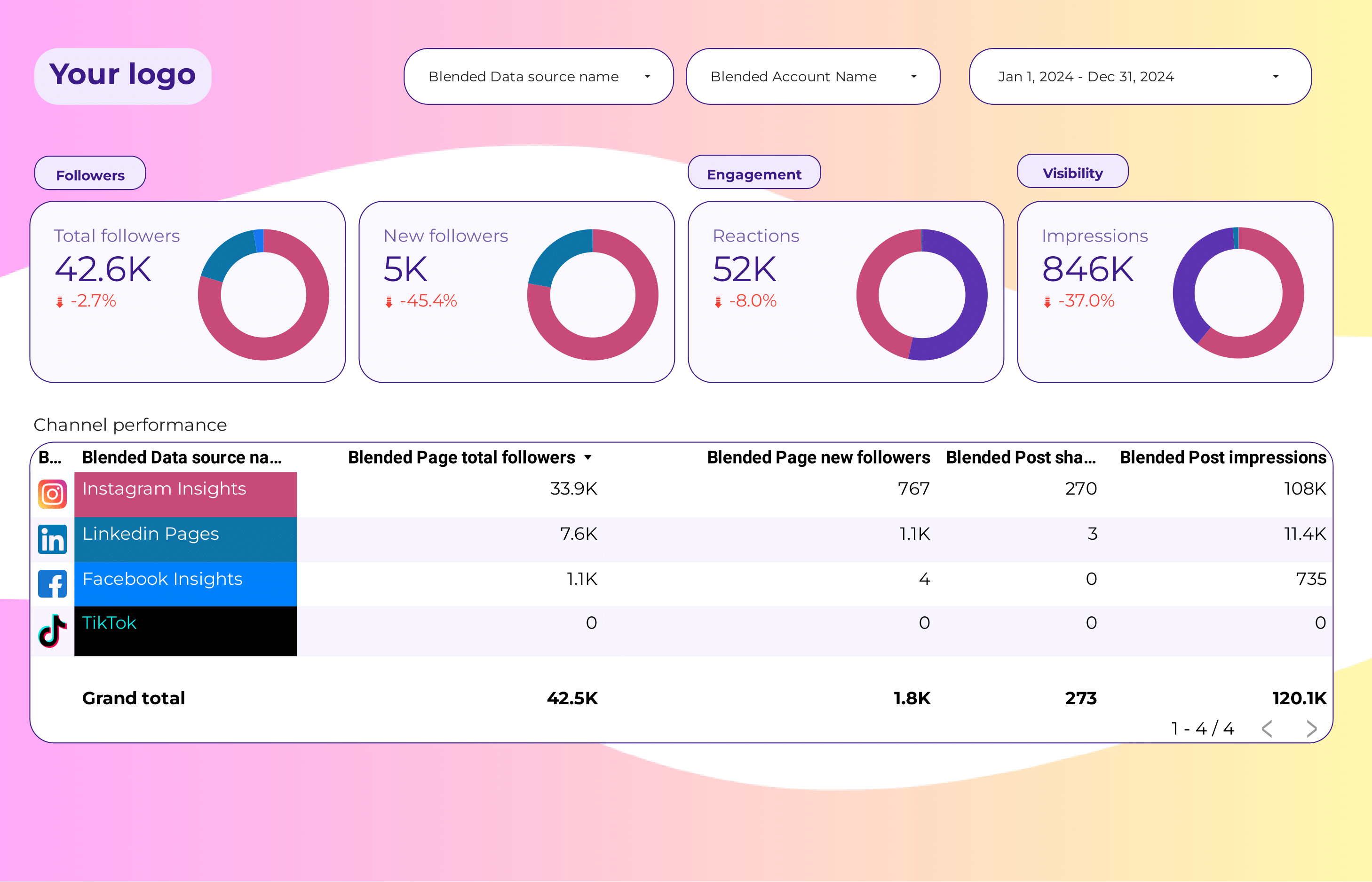
Social Media Dashboard template
Introducing the Social Media Dashboard Template, designed for seamless integration with platforms like Instagram Insights, Facebook Insights, LinkedIn Pages, TikTok, Google Business Profile, and Pinterest.
This template provides a centralized hub for monitoring and analyzing your social media performance. It supports:
- Instagram Insights for tracking engagement metrics and audience demographics.
- Facebook Insights to evaluate post reach and interaction statistics.
- LinkedIn Pages for assessing follower growth and content engagement.
- TikTok analytics to understand video performance and audience trends.
- Google Business Profile for visibility and customer interaction data.
- Pinterest metrics to measure pin performance and audience reach.
Utilize this dashboard to streamline your social media strategy and make informed decisions based on real-time data.

Shopify KPIs Dashboard template
The Shopify KPIs Dashboard Template is designed for e-commerce businesses using Shopify to track and analyze their performance metrics. This dashboard provides a clear view of your store’s critical performance indicators, enabling data-driven decision-making.
With this template, you can monitor:
- Sales Performance: Track total sales, average order value, and conversion rates.
- Customer Insights: Analyze customer acquisition, retention rates, and lifetime value.
- Product Analytics: Evaluate product performance, including bestsellers and inventory levels.
- Traffic Sources: Understand where your traffic is coming from and which channels are most effective.
Utilize this dashboard to maintain a comprehensive overview of your Shopify store’s performance, ensuring you stay informed and responsive to market trends.
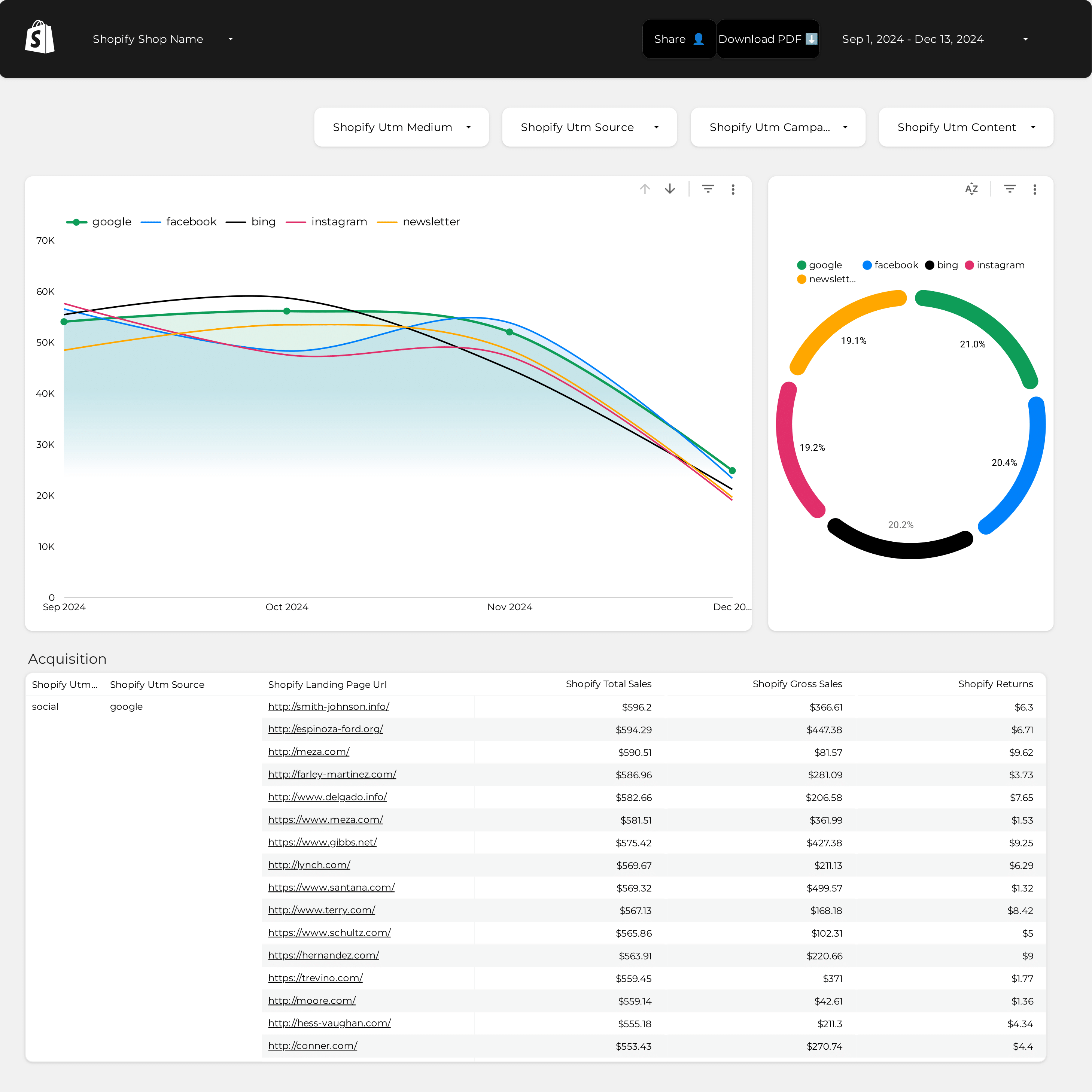
Shopify Attribution Dashboard template
The Shopify Attribution Dashboard template is designed for e-commerce businesses using Shopify to track and analyze their marketing efforts. This dashboard provides a detailed view of how different marketing channels contribute to sales and customer acquisition.
With this template, you can:
- Track PPC Campaigns: Monitor the performance of your pay-per-click campaigns across various platforms.
- Analyze Attribution Models: Understand the impact of different attribution models on your sales data.
- Visualize Customer Journeys: Gain insights into the paths customers take before making a purchase.
- Measure ROI: Calculate the return on investment for each marketing channel.
This dashboard integrates seamlessly with Shopify, providing real-time data and analytics to help you make informed decisions about your marketing strategies.
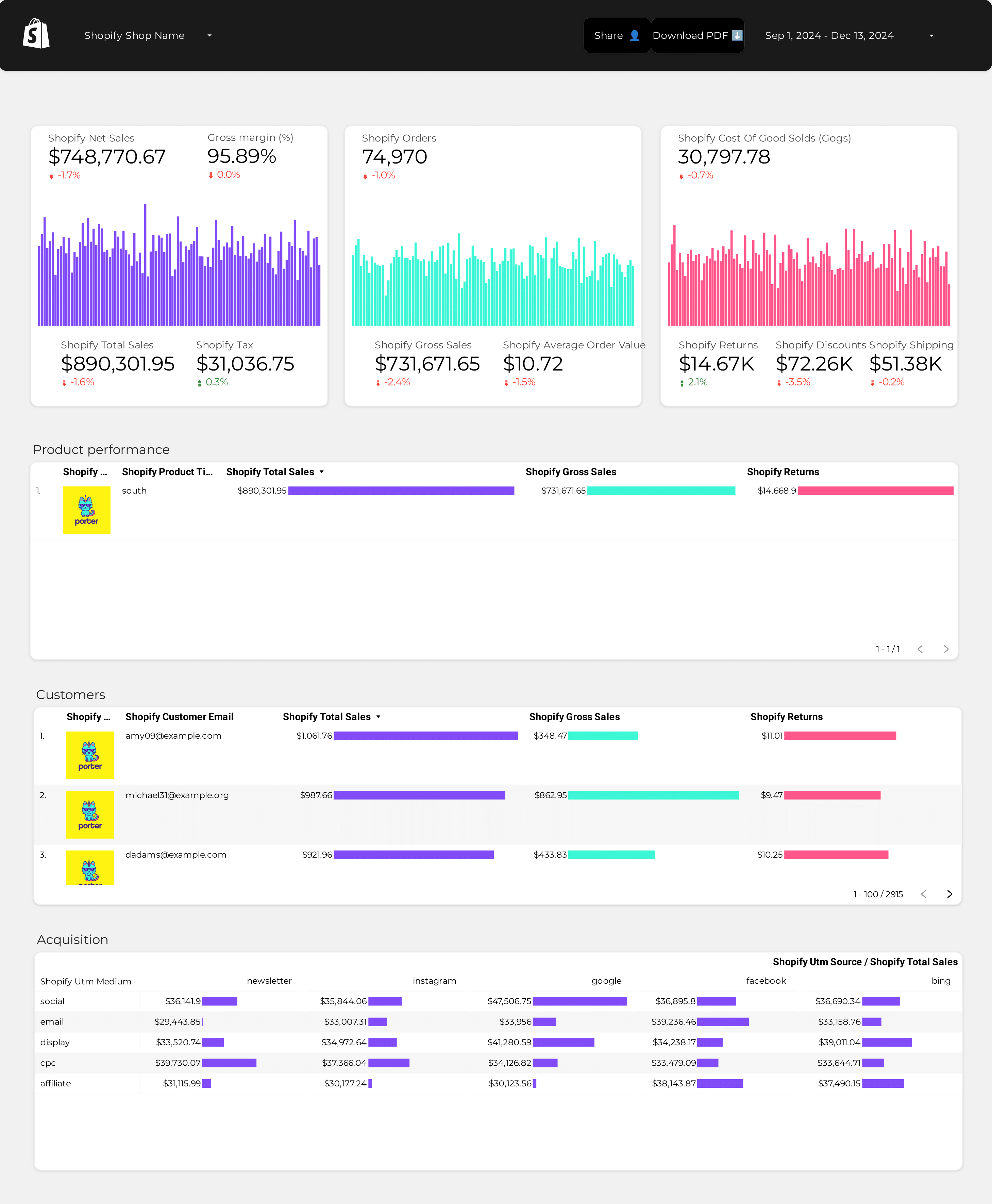
Shopify Dashboard template
The Shopify Dashboard Template is designed to provide a streamlined overview of your e-commerce operations. This template integrates seamlessly with Shopify, offering a centralized hub for monitoring and managing your online store’s performance.
With this dashboard, you can:
- Track Sales Data: Access real-time sales figures and analyze trends over time.
- Monitor Inventory Levels: Keep an eye on stock availability to ensure timely restocking and avoid stockouts.
- Analyze Customer Behavior: Gain insights into customer purchasing patterns and preferences.
- Review Marketing Campaigns: Evaluate the effectiveness of your marketing efforts and adjust strategies accordingly.
This template is an essential tool for any Shopify store owner looking to maintain a competitive edge in the e-commerce landscape.
